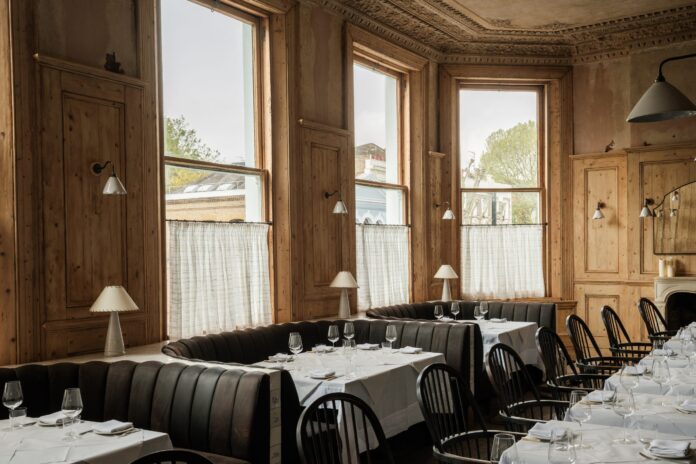The stage is set. The ribbon has been cut on British Summer Time, the clouds have parted, the trees are blossoming and it’s Mother’s Day. Today is for pulling out all the stops, of finding that joie de vivre which winter did its best to dampen, and giving your ma a day off from the stoves.
And almost as if they knew we’d be celebrating, farming collective Ladies in Beef have called their Great British Beef Week early, to coincide with the big day. Looks like your Mother’s Day menu has written itself, then. Here are 7 steps of the IDEAL roast beef Sunday lunch.
FARM TO TABLE
When roasting beef right, the key decisions are taken before you slap your meat on the counter or turn on the oven. That’s because the hard graft has already been done, on the farm. If you want a really, truly tasty piece of meat, then you’ll want to make sure it’s been ethically raised and sourced.
Buy independently, from a local butcher if you can, so your meat’s provenance is easier to trace. These guys care deeply about their product, not just the coin it’ll make. You’ll be supporting a local business too, not some multi-conglomerate who couldn’t care less about your stomach’s welfare, let alone an animals’. A no brainer, really. Avoiding supermarkets also helps you avoid vacuum packed, plastic wrapped meat (meat sweats? no thankyou).
You’ll want to choose a cut of beef ideally suited for roasting, which will depend on the amount of time and money you’ve got at your disposal. Whatever you go for, there needs to be a natural covering of fat and good marbling for maximum flavour. Roasting on the bone imparts even more, so for us, it has to be a rib of beef. The forerib, preferably dry aged, with the chine removed for easier carving is ideal.
SALT & DRY
Many see the words ‘days in advance’ and banish the recipe to the bin, but this really takes no extra effort. A little dry brine the day before cooking (salt added on all sides) will bring about more tender meat and a more thorough seasoning. Rest on a wire wrack uncovered in the fridge until the cook.
Bring your meat to room temperature for at least an hour before it hits the heat; there’s no point making the oven and meat work to get up to temperature, you’ll only waste time and energy. No need to season further just now.
Read: 7 Tips for the IDEAL Roast Chicken
LOW & SLOW
A low and slow roast will cook the rib most evenly and help you achieve that edge to edge medium rare finish. Lovely stuff. We’re talking really low, like 60°C for four to five hours. Basically, you want the internal temperature to reach 55°C for medium rare, so have a meat thermometer to hand for periodical checking.
There’s some debate about whether to brown the meat before the long, languid cook or after it. We’re of the mindset that post oven is better, as the exterior will take less time to develop that much sought after crust, therefore having less impact the interior temperature. Do this in a screaming hot pan with a thin layer of neutral oil of low smoking point, browning the meat on all sides until it’s got healthy char but isn’t burnt. Then, season lightly with flakey sea salt and let your joint rest for an hour. Do not skip this step, instead use the time to complete the other tasks.
GET THOSE ROASTIES RIGHT
Almost as important as the meat are the roasties. First things first, choosing the right spud variety is essential to the fluffy interior, crispy exterior that we’re surely all seeking. General wisdom suggests that you want a floury – as opposed to waxy – variety, such as King Edward’s or Maris Piper.
Once they’re peeled and cut into a medium, uniform size, it’s good to rinse some starch off the spuds, preferably in a sieve or colander under cold, running water. The starch eventually turns into glucose, which caramelises excessively. Burnt edges are not what we’re after, as they won’t crisp. You could even soak the potato overnight if you’re patient enough.
Next, boil your spuds from a cold start, with a little salt in the water. We want them to be soft, fluffy and yielding, but not lose their shape. It’s often a game of who blinks first, but take them as far as you can, as long as they’re still retaining their shape. A little roughed-up around the edges is fine; desirable even.
Being careful not to break the potatoes, carefully transfer them to a wire rack to air dry, using a slotted spoon for a controlled transition. Once they’re completely dry and cool, move them to the fridge to get cold. Again, overnight is best here, as the extra time in the fridge removes any moisture still present, promoting the crispiest finish.
Have your oven heated to 200°C in advance, and use some of the beef fat which rendered from the roasting process (you can buy more in any good supermarket) to coat your spuds. Season with salt and roast until crispy, which should take roughly the same amount of time as the rib’s rest. Finish with a little more salt.
Read: What To Do With Leftover Roast Lamb; Our 5 IDEAL Dishes
GIVE YOUR ALL TO GRAVY
Without a good gravy, a roast dinner is nothing more than a selection of dry ingredients which haven’t been properly introduced. We’ve written more about making a great gravy here, but to be beef specific, make sure you use a beef stock or even better, veal, as your base, and perhaps whisk some roasted bone marrow through at the end for a really luscious finish.
YORKIES MATTER
Your mum would never skip on the Yorkshire puddings, and you shouldn’t either. Especially with beef, they’re an essential component of a great roast dinner. We’ve got your back with this extensive rundown of how to do them right.
PAIR THOUGHTFULLY
A Great British mistake when cooking Sunday Lunch is to pay so much attention to the meat and potatoes that all other elements become an afterthought. But choosing the right vegetables and condiments, ones which pair particularly well with beef and bring out the best in each other, is the easiest way to elevate your roast from good to great.
It should go without saying that a good quality horseradish or mustard marries beautifully with beef. In terms of vegetables, we think celeriac is the king of companions, as well as roasted shallots and a bitter green like swiss chard. In your roasting tin at some point should be some thyme or rosemary, too, another perfect pairing with beef. And of course, don’t forget to choose an appropriate wine. Bon appetit!





